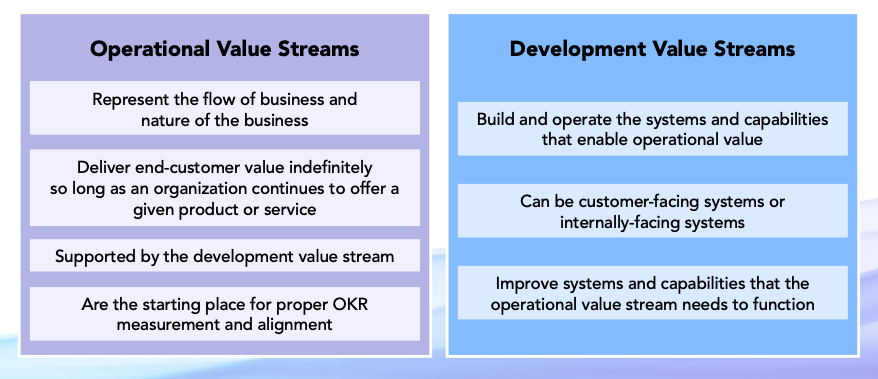
For many organizations, Agile gains a foothold in a small set of teams that plainly demonstrate its potential. Excited by the results, leaders begin to focus on scaling Agile – but soon discover that it requires some fundamental shifts. One of the most important components of Agile at scale is switching the way work gets done, from temporary, project-based teams to alignment around value streams.
What are value streams, and how do they work? And what is the difference between operational vs. development value streams? Read on.
What is a value stream?
A value stream is defined as an end-to-end business process and the associated steps an organization takes to deliver customer value. It can also be understood as a line of business that delivers value, typically a product or service, to a customer. In practice, this looks like a number of teams working together in teams of teams, also known as Agile Release Trains (ARTs), tribes, or flights, to manage, plan, and coordinate work together.
Value streams differ from traditional project models in several ways:
- They are comprised of long-lived, cross-functional teams and teams of teams instead of temporary groups organized around a specific project.
- Because the teams operate on an on-going basis, they are able practice continuous improvement. Temporary teams, on the other hand, are always starting from scratch, with little opportunity to improve performance and efficiency.
- As the name suggests, value streams connect work back to the ultimate value that it delivers to the customer and/or business. With traditional projects, the real value is often obscured by project-centric metrics like being on-time and on-budget.
Aligning around value: Two types of value streams
Defining the precise value that your organization delivers, to whom, is the first step in any value stream initiative. This may be simple or trickier than you would expect. It’s an important exercise to uplevel beyond project metrics and operational checkpoints to truly understand why your organization does what it does.
When you have defined the value provided by the business, you can begin to construct your value streams. The exact composition of value streams will look different at different organizations. Most, however, fall into two categories: operational value streams and development value streams. Both result in the creation of value for a customer (internal and/or external) and can come in the form of products, services, or a combination of the two.
Operational value streams correspond directly to a specific value driver.
They:
- Represent the flow of business and the nature of the business
- Deliver end-customer value indefinitely as long as an organization continues to offer a given product or service
- Are supported by development value streams
- Use OKRs (objectives and key results) to set, communicate, and monitor goals
Development value streams support operational value streams.
They serve as the subsystems that ensure the operational value stream can operate successfully.
Development value streams:
- Build and operate the systems and capabilities that enable operational value
- Can be customer-facing systems or internally-facing systems
- Improve systems and capabilities that the operational value stream needs to function

Focus on what matters: customer value
Value streams offer a construct for businesses to organize and operate around what really matters: the value they deliver to customers. While the process may initially seem complex, it often results in much greater clarity into the relationships between the work that gets done and the value that it provides. That insight, in turn, opens the door to the many benefits of Agile, from efficiency to productivity and beyond.
For a deeper dive into the two types of value steams and for a specific example to help illustrate how operational and development value streams work together, I invite you to download the eBook: “The 2 Types of Value Streams: Aligning the Organization Around Value” or watch the on-demand webinar “How to Identify Your Value Streams” with Jon Terry, Chief Evangelist Lean-Agile Strategy at Planview, and Siraj Sirajuddin, Co-Founder of Temenos + Agility. They will teach you why identifying your value streams is a critical Agile transformation.




